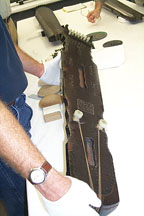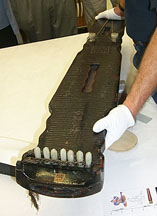|
On July 19, 2002, as a member of The New York Qin Society, I had the honor of joining a trip to visit the Freer Gallery of Art in Washington DC. "Ku Mu Long Yin" (Dragon's Moan in the Withered Wood) is one of the best pieces in their qin collection. Mr. Zheng Ming-zhong*  (1923-2019), Research Fellow at the National Palace Museum, Beijing, who
visited the Freer Gallery in November 1999 determined that
this instrument was made in the middle Tang period (approximately 766-826AD) by the Lai family. (1923-2019), Research Fellow at the National Palace Museum, Beijing, who
visited the Freer Gallery in November 1999 determined that
this instrument was made in the middle Tang period (approximately 766-826AD) by the Lai family. However, I recently (July 2021) learned that according to the book, [Dragon's Roar - Chinese Literati Musical Instruments in The Freer And Sackler Collections] by Yang Yuanzheng, published in Oct 2020, after the study of CAT scans of this qin and careful examination, that this qin was made in 1009, during the Song dynasty. Please click the pictures for bigger images. | |||
 |
The form of this qin is Lian Zhu Shi (continued pearl style). The size of this instrument is 123cm in total length, according to Mr. Zheng's measurement. | ||
 |
The tail is made of sandalwood. The width is 14.8 cm, according to Mr. Zhen's measurement. | ||
 |
Sloping rounded edges with cracking lacquer showing underneath the deer horn ash coating. The goosefeet are made of white green jade with carving. | ||
 |
Gold Dots. On the surface of the lacquer, can be seen the snake-belly cracks interspersed with cow-hair cracks with sword point. | ||
 |
Closer view of the cracks. | ||
 |
The bottom view of the qin. The dragon pool has 4 continuous curves. The phoenix pond has 3 continuous curves. Above the dragon pool, there are engraved 4 characters, "Ku Mu Long Yin" with running cursive script. Between the pond and pool there is the big square seal "Qing He" (Pure harmony) in seal character. | ||
 |
The head part of the instrument is 19.5cm width, according to Mr. Zheng's measurement. Tuning pegs are made of white green jade. | ||
 |
The dragon pool. According to Mr.Zheng's examination, he found that the edge of the pool and pond were well inlaid with paulownia wood (Tong Wood). On the opposite corners at the bottom part of the inlaid has bamboo nails. The neck has smoothly rounded edges. | ||
 |
Beside the each side of the dragon pool, there is engraved the cursive script inscription: Da Shen Yi Yin. Hun Rang Tian Cheng. Wuan Lai You You. Sheng Hai Guei Jing. (Tones bequeathed from the great saint. An integral entity made by god. Melodious reigns supreme. God astonished and devil frightened). | ||
 |
The white green jade goosefeet and the big square seal "Qing He" (Pure harmony)
in seal characters.
| ||
* From the article  which was published in which was published in
 the 5th vol. Sept. 2000 of the periodical of the National Palace Museum, Beijing. the 5th vol. Sept. 2000 of the periodical of the National Palace Museum, Beijing.Very many thanks to Dr. Marilyn Wong Gleysteen for setting up this special trip. Thanks to Dr. Julian Raby, Director, Smithsonian Institution, Freer Gallery of Art and Arthur M. Sackler Gallery; Dr. Paul Jett, Chief Conservator; Ms. Jan Stuart, Associate Curator of Chinese Art; Stephen Allee, Translator; and Tim Kirk, Art Handling Specialist for giving us access to this piece. Thanks to the photographer, Stephen Bourne. | |||